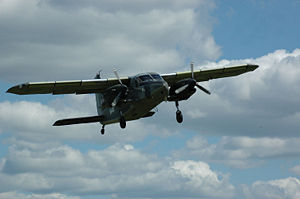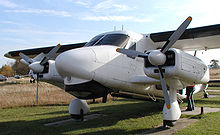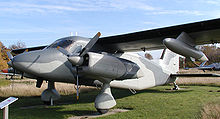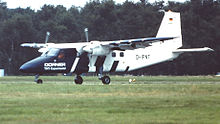- Dornier Do 28
-
Do 28 Skyservant Dornier Do 28 G.92 turboprop conversion Role STOL light utility aircraft Manufacturer Dornier Flugzeugbau GmbH First flight 29 April 1959 Status In civilian use Primary user Luftwaffe Developed from Dornier Do 27 Developed into Dornier Do 228 The Dornier Do 28 Skyservant is a twin-engine STOL utility aircraft, manufactured by Dornier Flugzeugbau GmbH. It served with the Luftwaffe and Marineflieger and other air forces around the world in the communications and utility role.
Contents
Design and development
The Do 28 was developed from the single-engine Do 27 at the end of the 1950s. The design shared the high-wing cantilever layout and the lift augmentation devices of the Do 27, together with the rear fuselage which seated six passengers.
The most defining feature of the new design was the unusual incorporation of two Lycoming engines, as well as the two main landing gear shock struts of the faired main landing gear attached to short pylons on either side of the forward fuselage.
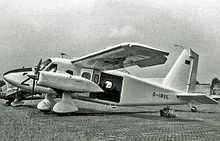 The second Dornier Do28D exhibited at the Paris Air Show in June 1967
The second Dornier Do28D exhibited at the Paris Air Show in June 1967
The internal space of the Do 28 was the same as the Do 27 and the company was given financial assistance from the German government to develop a larger STOL transport to carry up to 13 passengers.[1] The type was designated the Do 28D and later named Skyservant. The Do 28D was a complete redesign and shared only the basic layout and wing construction of the earlier versions. The fuselage and engine nacelles were rectangular, unlike the rounded Do 28A/B. The aim was to develop a simple and rugged aircraft for use under arduous conditions, which could be easily maintained. With a crew of two pilots, the cabin accommodated up to 12 passengers; freight could be loaded easily through large double doors and with the seats removed the cabin gave 283 sq ft (26.3 m2) of unobstructed space. The first flight of a Do 28D took place on 23 February 1966[2] and the type was publicly exhibited at the Paris Air Show at Le Bourget airport in June 1967.
A further variant of the Skyservant was the Do 28D-2/OU (Oil Unit). Two aircraft were fitted with radar and SLAR (Side-Looking Airborne Radar) to monitor oil pollution in the Baltic and North Seas. Painted in a white scheme, they were operated between 1984 and 1995 by MFG 5 of the Marineflieger, on behalf of the German Transport Ministry. These aircraft are easily recognised by the fuselage-mounted SLAR antenna and a radome under the cockpit. In 1991, both aircraft operated for several weeks in the Persian Gulf during the Gulf War under the control of the United Nations. These two aircraft were replaced by the Do 228 at the end of 1995. These Skyservants are preserved in the museum at Nordholz.
Like the Do 27, the Dornier Do 28 possessed a high cruising speed, excellent low-speed handling characteristics, as well as very short takeoff and landing (STOL) performance. The Do 28 was readily accepted as a natural progression from its single-engine forebear. With many of the same STOL characteristics, most Do 28 production was destined for military customers, notably Germany, although a small number were in service for commercial operators as a rugged, low-cost utility transport. The design proved remarkably adaptable and was developed into a number of progressively improved variants, from the original D, through the D1 and D2 to the 128-2, introduced in 1980. Each variant introduced a number of detail changes that enhanced its already versatile performance capabilities.
In 1997, the Hungarian engineer Andreas Gál developed a conversion based on a D-variant, that was intended to meet the requirements of skydivers. Instead of the Lycoming piston engines, Gál had two Walter M601-D2 turboprops, modified three-blade propellers and a skydiving kit installed by Aerotech Slovakia on seven planes. Although CAA, Hungary's aviation authorities, instantly certified the conversion, the JAA-certification could not be applied for before 2007, due to certification restrictions on the engines. In 2008, there have been six planes flying in Europe, all of them Hungarian registered, mainly at dropzones in Soest, Germany, Wiener Neustadt, Austria and Target Skysports, Hibaldstow in the United Kingdom.
Operational history
A total of 121 Dornier Do 28D-2s were built between 1971 and 1974 at Oberpfaffenhofen for the Bundeswehr (German Federal Armed Forces) where they replaced ageing Percival Pembrokes,[2] they served until the introduction of the Dornier Do 228 in 1994, predominantly as a transportation and communications aircraft. 20 aircraft were transferred to the Marineflieger, 10 served from 1978 in the maritime reconnaissance role, additional underwing fuel tanks were fitted for extended endurance (see photo). The high noise levels and vibration in the cabin led to the type's replacement by the significantly quieter turboprop-powered Do 228. During the 20 years in German military service, only three aircraft were lost to accidents.
The Do 28D was flown in 30 countries around the world and is still in service today. More than 150 aircraft were built. In the German Federal Armed Forces jargon, the Skyservant was called the "farmer's eagle" and was regarded as a reliable "workhorse". Turkey received two specially equipped SIGINT aircraft with the code name of 'Anadolou' as well as the normal transport version.
Variants
- Do 28
- Prototype, first flew 29 April 1959 with two 180 hp (130 kW) Lycoming O-360-A1A engines and fixed pitch two-blade propellers.
- Do 28A-1
- Designation of production aircraft with 250 hp (190 kW) Lycoming O-540-A1A engines and a 7 ft increase in wingspan, 60 built. First flown on 20 March 1960 at Oberpfaffenhofen. One aircraft was used for the personal transport of the German Defense Minister, Franz Josef Strauss.[3]
- Do 28A-1-S
- Floatplane conversion of the Do 27A-1 by the Jobmaster Company of Seattle, Washington, USA.
- Do 28B-1
- Do 28A with enlarged nose, additional fuel tanks, increased tailplane area and powered by 290 hp (220 kW) Lycoming IO-540 fuel injected engines and three-blade constant speed propellers, 60 built.
- Do 28B-1-S
- Proposed floatplane conversion of the Do 28B-1 by the Jobmaster Company of Seattle, Washington, USA.
- Do 28B-2
- Variant with turbocharged Lycoming TIO-540 engines, one built.
- Do 28C
- Designation of a proposed eight-seat version with two 530 shp turboprops but this design was not pursued.
- Do 28D
- Redesigned aircraft with box fuselage, larger wing, new tail and two 380 hp (280 kW) IGSO-540 engines, seven built.[4]
- Do 28D-1
- Production version of the Do 28D, with 0.5 m (1 ft 7½ in) greater wingspan and higher gross weight.[4] 54 built.
- Do 28D-2
- Increased maximum takeoff weight, strengthened fuselage with enlarged cabin,[5] 172 built.
- Do 28D-2/OU
- Do 28D modified as a pollution patrol aircraft
- Do 28D-2T
- In 1980 one Luftwaffe Do 28D-2 aircraft was fitted with two Avco Lycoming TIGO-540 turbochared engines.
- Do 28D-5X Turbo Skyservant
- Prototype version powered by Lycoming LTP-101-600 turboprops rated at 298 kW (400 shp) each. One built, first flying on 9 April 1978. Also known as the TurboSky.[6][7]
- Do 28D-6X Turbo Skyservant
- Prototype version powered by PT6A-110 turboprops, also rated at 298 kW (400 shp) each. One built, first flying on 4 March 1980 later redesignated Dornier 128-6.[7]
- Do 28E-TNT
- A Do 28D fitted with a new, high technology wing (Tragflugel Neuer Technologie - New Technology Wing) of 19.97 m (55 ft 8 in) span for trials, powered by two 533 kW (715 shp) Garrett TPE331-5-252D mounted on the wing. One built, first flown on 14 June 1979.[8] Wing later used in the Dornier Do 228.[9]
- Do 28 G.92
- 1997 Slovakian conversion of Do 28D powered by two Walter Engines M601-D2 450 hp (340 kW) turboprops used for skydiving operations, seven built
- Do 128-2
- Improved version of Do 28D-2, replaced D-2 in 1980.[7]
- Do 128-6
- Production version of the Turbo Skyservant,[7] six built.
Operators
Military operators
- Angolan Air Force
- Benin Air Force
- Israel Defence Force
- Police Mobile Unit
- Military of Mozambique 3 Dornier 28 in service
- Serbian Air Force
- Zambian Air Force
Specifications (Do 28B-1)
Data from Jane's All The World's Aircraft 1965-66 [10]
General characteristics
- Crew: 1
- Capacity: 7 passengers
- Length: 9.00 m (29 ft 6 in)
- Wingspan: 13.80 m (45 ft 3½ in)
- Height: 2.80 m (9 ft 2 in)
- Wing area: 22.7 m² (241 sq ft)
- Airfoil: NACA 23018 (modified)
- Aspect ratio: 8.5
- Empty weight: 1,730 kg (3,806 lb)
- Max takeoff weight: 2,720 kg (5,984 kg)
- Powerplant: 2 × Lycoming IO-540A air-cooled flat-six, 216 kW (290 hp) each
- Propellers: Harzell three-bladed propeller, 1 per engine
- Propeller diameter: 2.03 m (6 ft 8 in)
Performance
- Never exceed speed: 334 km/h (180 knots, 207 mph)
- Maximum speed: 290 km/h (160 knots, 184 mph) at sea level
- Cruise speed: 242 km/h (130 knots, 150 mph) at sea level (econ. cruise)
- Stall speed: 70 km/h (38 knots , 44 mph)
- Range: 1,235 km (668 nmi, 768 mi) (max payload)
- Ferry range: 1,680 km (957 nmi, 1,100 mi) (auxiliary fuel)
- Service ceiling: 6,300 m (20,700 ft)
- Rate of climb: 7.1 m/s (1,400 ft/min)
Specifications (Do 28D-2)
Data from [11]
General characteristics
- Crew: 1 or 2 pilots
- Capacity: 12 passengers
- Length: 11.41 m (37 ft 5 in)
- Wingspan: 15.55 m (51 ft)
- Height: 3.9 m (12 ft 10 in)
- Wing area: 29 m² (312 ft²)
- Empty weight: 2,328 kg (5,132 lb)
- Loaded weight: 3,647 kg (8,040 lb)
- Max takeoff weight: 4,350 kg (9,590 lb)
- Powerplant: 2 × Lycoming IGSO-540-A1E 6-cylinder piston engine, 285 kW (380 hp) each
Performance
- Maximum speed: 323 km/h (175 kn, 201 mph)
- Cruise speed: 306 km/h (165 kn, 190 mph)
- Range: 1,050 km (567 nmi, 652 mi)
- Service ceiling: 7,680 m (25,200 ft)
- Rate of climb: 5 .8 m/s (1,160 ft/min)
See also
- Related development
- Dornier Do 27 (predecessor)
- Dornier Do 228 (successor)
- Aircraft of comparable role, configuration and era
References
Notes
- ^ The Illustrated Encyclopedia of Aircraft 1985
- ^ a b Jackson 1976, p. 32.
- ^ Jackson 1976, p. 62.
- ^ a b Air International, January 1979, p. 16.
- ^ Air International January 1979, p.17.
- ^ Air International January 1979, pp. 43–44.
- ^ a b c d Taylor 1982, pp. 82–83.
- ^ Air International October 1979, pp. 188–191.
- ^ Air International October 1987, pp. 163–166.
- ^ Taylor 1965, pp. 69–70.
- ^ "Do 28." Airliners.net. Retrieved: 11 March 2010.
Bibliography
- "Dornier's Way With Commuters". Air International, October 1987, Vol. 33, No. 4, pp. 163–169, 201–202.
- "Fashionably Old Fashioned: Dornier's Versatile Skyservant". Air International, January 1979, Vol. 16 No. 1. pp. 13–17, 43–44.
- Green, William. The Observer's Book Of Aircraft. London. Frederick Warne & Co, Ltd, 1968.
- The Illustrated Encyclopedia of Aircraft (Part Work 1982-1985). London: Orbis Publishing, 1985.
- Jackson, Paul A. German Military Aviation 1956-1976. Hinckley, Leicestershire, UK: Midland Counties Publications, 1976. ISBN 0-904597-03-2.
- "On Test...Dornier's New Technology Wing". Air International, October 1979, Vol. 17 No. 4. pp. 188–191.
- Taylor, John W. R. Jane's All The World's Aircraft 1965-66. London: Sampson Low, Marston & Company, 1965.
- Taylor, John W. R. Jane's All The World's Aircraft 1982-83. London: Jane's Yearbooks, 1982. ISBN 0-7106-0748-2.
External links
Aircraft built by Zeppelin-werke Lindau(Dornier) and Dornier Flugzeugwerke Idflieg designations
1914-1919Company designations
pre-1933RLM designations
1933-1945Do 10 • Do 11 • Do 12 • Do 13 • Do 14 • Do 15 • Do 16 • Do 17 • Do 18 • Do 19 • Do 20 • Do 22 • Do 23 • Do 24 • Do 25 • Do 26 • Do 29 • Do 212 • Do 214 • Do 215 • Do 216 • Do 217 • Do 317 • Do 318 • Do 335 • Do 417 • Do 435 • Do 635
P.59 • P.85 • P.174 • P.184 • P.192 • P.231 • P.232 • P.238 • P.247 • P.252 • P.254 • P.256 • P.273 • P.1075
Company designations
post-1945Lists relating to aviation General Aircraft (manufacturers) · Aircraft engines (manufacturers) · Airlines (defunct) · Airports · Civil authorities · Museums · Registration prefixes · Rotorcraft (manufacturers) · TimelineMilitary Accidents/incidents Records Categories:- Dornier aircraft
- German military utility aircraft 1960–1969
Wikimedia Foundation. 2010.

